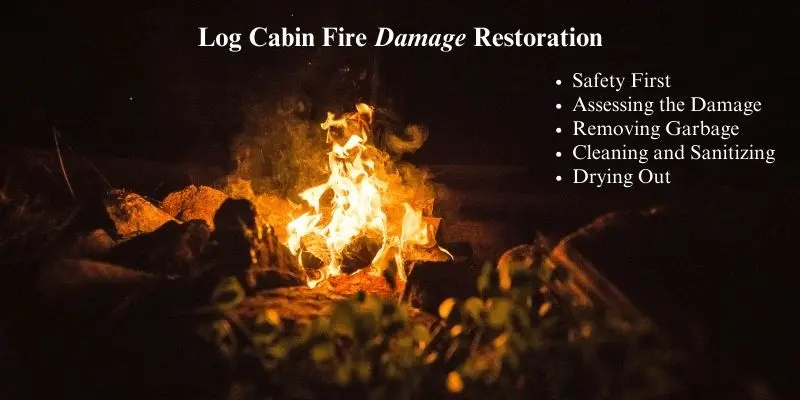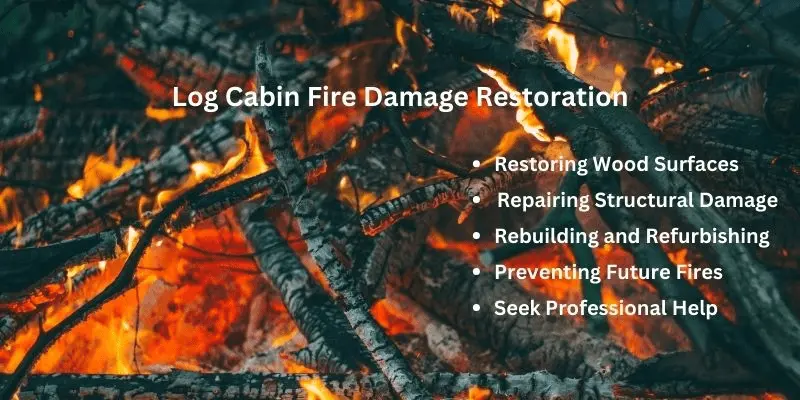10 Steps for Log Cabin Fire Damage Restoration: A Comprehensive Guide
Updated: 13 Feb 2024
172
Log cabin fire damage restoration is a careful and detailed process. The goal is to make the cabin look like it did before the fire. When a log cabin gets damaged by fire, it’s not just the structure that’s affected, but also its special character. People who specialize in fixing log cabins know how important it is to keep the logs looking natural while also fixing any structural problems caused by the fire.
The restoration involves cleaning, taking out burned or damaged logs, and putting in new ones that match the rest of the cabin. Sometimes, experts use methods like media blasting or chemical stripping to get rid of stains from smoke and soot without hurting the wood.
The whole process tries to find a balance between using modern techniques and keeping the traditional look of the cabin. The goal is to bring the log cabin back to how it was, keeping its original charm and character. Below, we provide a comprehensive damage restoration guide, ensuring the safety, thoroughness, and renewal of your appreciated log cabin.
Steps for log cabin fire damage restoration
For log cabin fire damage restoration, the following steps should be adopted.

Step 1: Safety First
The first step in any restoration process is to prioritize your safety. Before entering the cabin, make sure that the structure is safe and stable. Check for any structural damage or signs of collapse, such as leaning walls or sagging rooflines. If there are any doubts about the safety of the cabin, it is crucial to seek professional help before attempting any restoration work.
Safety should be the top priority when set on the restoration journey. Begin by:
- Ensuring the cabin is structurally sound and all utilities are turned off before re-entry.
- Documenting all damage, and taking notes of any safety risks or structural instabilities for reference.
- Assessing the type and strictness of the damage, distinguishing between light soot, widespread charring, and structural concerns.
Once you have confirmed the cabin is safe to enter, ensure that you wear protective gear such as gloves, masks, and goggles to protect yourself from any potential toxins or debris. Make sure to also turn off all utilities including electricity and gas before entering the cabin.
Step 2: Assessing the Damage
After ensuring your safety, the next step is to assess the extent of the damage. This will help you determine the necessary restoration measures and create a plan of action. Take pictures or videos of the damage for insurance purposes and make a list of all damaged items.
Step 3: Removing Garbage
Before starting any cleaning or restoration work, it is important to remove all garbage and burnt materials from the cabin. This will make it easier to assess the damage and prevent any further structural damage. Use a shovel, broom, and dustpan to carefully remove garbage and dispose of it properly.
Step 4: Cleaning and Sanitizing
After removing all garbage, thoroughly clean and sanitize all surfaces in the cabin. Soot, smoke residue, and water used to extinguish the fire can cause further damage if left unattended. Use a mixture of water and mild detergent to clean walls, floors, ceilings, and other surfaces. For heavy soot or smoke damage, it may be necessary to use specialized cleaning products or seek professional help.
To rid your cabin of lingering signs of the fire, follow these steps:
- Carefully removing any salvageable items, working with professionals if necessary
- Engaging in detailed smoke and soot cleaning, which may involve specialist treatments for different surfaces.
- Neutralizing constant scent with the help of professionals—avoid over-the-counter remedies that can lead to temporary relief.
Step 5: Drying Out
After cleaning and sanitizing, it is important to dry out the cabin completely. Use fans and dehumidifiers to speed up the drying process and prevent any mold or mildew growth. Ensure proper ventilation to avoid trapping moisture in the cabin

Step 6: Restoring Wood Surfaces
A log cabin’s charm lies in its beautiful wooden surfaces, which can be heavily damaged by fire. To restore these surfaces, start by sanding down any charred or stained areas. Then, apply a wood cleaner and brightener to remove any remaining stains and restore the wood’s natural color. Finally, apply a protective sealant or stain to prevent future damage.
Step 7: Repairing Structural Damage
If there is any structural damage to the cabin, it is important to have it repaired by a professional. This may include replacing burnt or damaged logs, repairing roof and floor joists, and reinforcing weakened areas.
Once the initial cleaning is complete, it’s time to restore the log cabin’s integrity by:
- Assessing and replacing any severely damaged logs, maintaining the cabin’s aesthetic with carefully selected matches.
- Assessing structural damage and consulting professionals for repairing compromised areas.
- Refinish the logs with the appropriate treatments to restore their natural beauty and protect against future damage
Step 8: Rebuilding and Refurbishing
After completing all necessary repairs, it is time to rebuild and refurbish your cabin. This may include repainting walls, replacing flooring, and adding new furnishings and decor. Take this opportunity to also add any safety features, such as fire alarms and sprinkler systems.
With a structurally sound cabin, you can focus on the interior:
- Replacing any damaged components such as windows, doors, and flooring with materials that match the original character.
- Updating electrical and plumbing systems as needed, which may also include safety checks and upgrades to meet current building codes.
- Tailoring the interior design to reflect your style, staying mindful of the cabin’s unique features.
Step 9: Preventing Future Fires
To avoid future fire damage, it is important to take preventative measures. This may include installing smoke detectors, keeping a fire extinguisher on hand, and regularly checking and maintaining all utilities and appliances. Additionally, make sure to have an escape plan in case of emergency.
Step 10: Seek Professional Help
Fire damage restoration can be a complex and time-consuming process. If you are unsure or overwhelmed at any point during the restoration, do not hesitate to seek professional help. They have the necessary expertise and equipment to ensure the thorough and safe restoration of your cabin.
Additional Tips and Recommendations
| Additional Tips and Recommendations |
|---|
|
FAQs
Can I restore my log cabin on my own?
Yes, it is possible to restore your log cabin on your own with the right approach and guidance. However, if you are unsure or overwhelmed at any point during the restoration, it is important to seek professional help.
How do I know if my log cabin is safe to enter after a fire?
Before entering the cabin, make sure to check for any signs of structural damage or collapse. If you have any doubts about the safety of the cabin, it is crucial to seek professional help before attempting restoration work.
Do I need special cleaning products to remove soot and smoke residue from my log cabin?
In most cases, a mixture of mild detergent and water will suffice for cleaning surfaces in your log cabin. However, for heavy soot or smoke damage, it may be necessary to use specialized cleaning products or seek professional help
Can I prevent future fires from occurring in my log cabin?
Yes, there are several preventative measures you can take to avoid future fire damage. These include installing smoke detectors, regularly maintaining utilities and appliances, and having an escape plan in case of emergency. Remember, always prioritize safety first!
How long does it take to restore a log cabin after fire damage?
The time it takes to fully restore a log cabin after fire damage will vary depending on the extent of the damage and the size of the cabin. It is important to thoroughly assess the damage and follow a step-by-step restoration process for the best results. Patience and thoroughness are key! Keep in mind, that it may also be necessary to seek professional help at certain stages of the restoration process.
Conclusion
Restoring a log cabin after fire damage may seem like a discouraging task, but with the right approach and guidance, it is possible to renew your beloved shelter. Remember to prioritize safety, thoroughly assess the damage, and seek professional help when needed. By following this step-by-step guide, you can confidently restore your cabin’s charm and create new memories in your re-energized space. So go ahead and roll up your sleeves – your log cabin restoration journey waits.
Please Write Your Comments